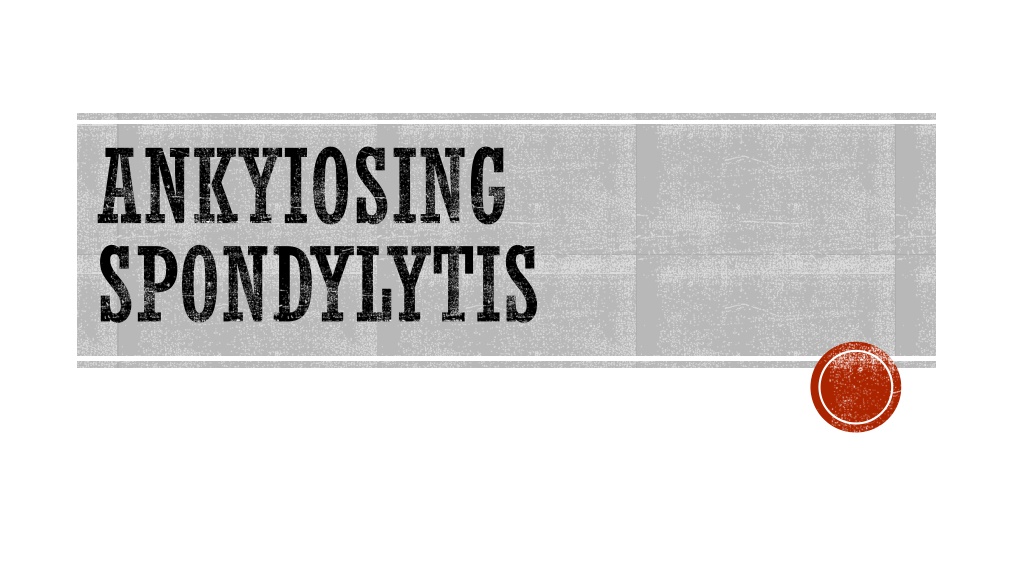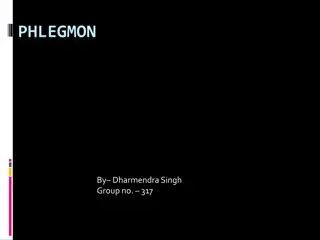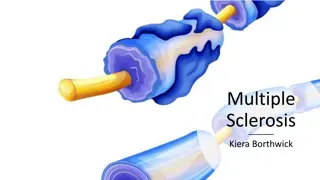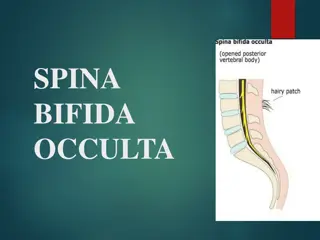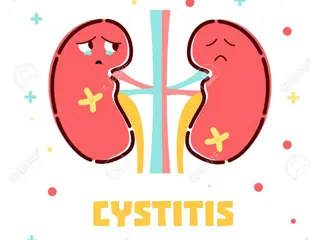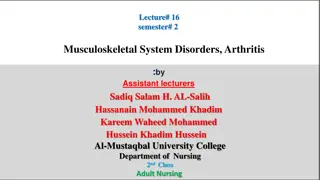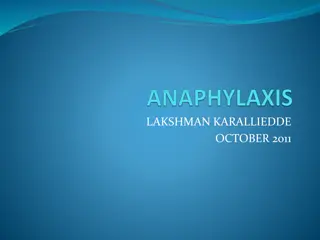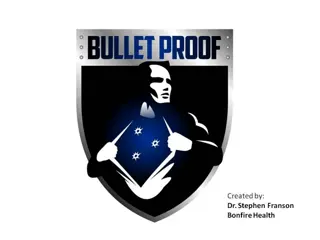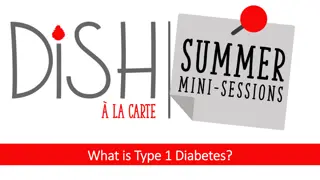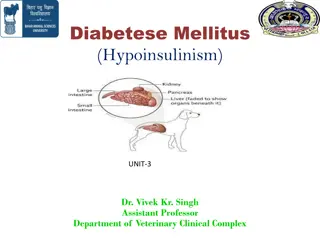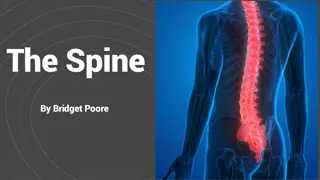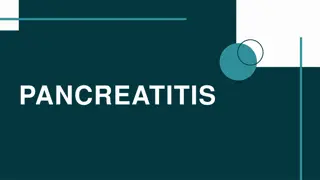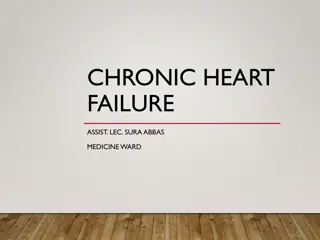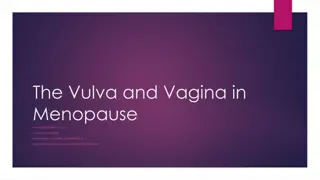Understanding Ankylosing Spondylitis: Causes, Symptoms, and Treatment
Ankylosing spondylitis is a chronic form of arthritis primarily affecting the spine. It leads to joint fusion and eventual rigidity, known as bamboo spine. The condition, more common in young men, is characterized by unknown causes but is believed to have genetic links. Inflammation-regulating factors like TNF and IL-1 play a role. Diagnosis and treatment are crucial in managing this systemic rheumatic disease.
Download Presentation

Please find below an Image/Link to download the presentation.
The content on the website is provided AS IS for your information and personal use only. It may not be sold, licensed, or shared on other websites without obtaining consent from the author. Download presentation by click this link. If you encounter any issues during the download, it is possible that the publisher has removed the file from their server.
E N D
Presentation Transcript
ANKYIOSING SPONDYLYTIS
INDEX Introduction. What cause ankylosing spondylitis? The ankylosing process. Signs and symptoms. Diagnosis. Treatment. Medication.
INTRODUCTION... Previously known as- Bechterew s disease. Bechterew syndrome. Marie Strumpell Disease.
It is a form of arthritis that is long lasting (chronic) and most often affected the spine. It affects joints in the spine and the sacroilium In the pelvis Causing eventual fusion of the spine.
COMPLETE FUSION RESULTS IN A COMPLETE REGIDITY OF THE SPINE, A CONDITION KNOWN AS BAMBOO SPINE.
As is a systematic rheumatic disease and is one of the seronegative Spondyloarthropathies. The typical patient is Young aged 18-30. Man are affected more than women by a ratio about of 3:1.
The causes of ankylosing spondylitis is unknown but a tendency to develop the condition may be Genetic. HLA-B27 genotype. -90% of patients. Tumor necrosis Factor-alpha (TNF-alpha). IL-1.
TNF... Tumortnecrosis factor(TNF cachexin or cachectin and formally known as Tumor necrosis factor-alpha) is a cytokine involved in a systematic inflammation. The primary role of TNF is in the regulation of Immune cells. TNF is also able to induce apoptotic cell death, to induce inflammation, and to inhibit tumorigenesis and viral replication.
IL-1... Interleukin-1(IL-1). The orginal members of the IL-1 superfamily are IL -1alpha, IL-1beta, and the IL-1 receptior antagonist (IL-1RA). IL-1alpha and beta are pro-inflammatory cytokines involves in immune defence against infection. The IL-1RA is a molecule that competes for receptor binding with IL-1alpha and IL- 1beta, blocking their roles in Immune activation.
SIGNS AND SYMPTOMS... Mild to severe back and buttock pain that is often worse in the early morning hours. This pain usually get better with activity. Continued inflammation of the : Ligaments. 1. Tendons. 2. Joint capsules (Soft tissues surrounding the joints). 3. Joints of the spine. 4.
Cause the spine to fused together(ankylose) as the joint and disc spaces are replaced by bones. Leading to less motion in the neck and low back. As the spine fuses or stiffens, the neck and low back lose their normal curve. The mid back curves outward(kyphosis) and a fixed bent-forward position can result; Leading to significant disability.
Inflammation of the small joints joining the ribs and collarbone to the breastbone. Cause less expansion of the chest wall with breathing. In 40% of cases, ankylosing spondylitis is associated with an inflammation of the white of the eye(iridocyclitis). Causing eye pain and photophobia.
Another Common symptom is generalized Fatigue. Less commonly Aortitis, Apical lung fibrosis and Ectasia of the sacral nerve root sheaths may occur. As with all the seronegative spondarthropathies lifting of the nails (Onycholysis) may occur.
A Blood test for the HLA-B27 gene. X-ray which shows the characteristic spinal changes and sacroilitis. Tomography and magnetic resonance imaging of the sacroiliac joints. But the reliability of these test is still unclear.
CHOBERS TEST... A useful clinical measure of flexion of the Lumbar spine performed during examination.
No cure is known for AS. Treatments and medications are available to reduce symptoms and pain.
Their are three major types of medications used for ankylosing spondylitis. Anti-inflammatory drugs- 1. Includes NSAIDs such as Aspirin, ibuprofen, phynylbutazone, indomethacin, naproxen, COX-2 inhibitors reduce inflammation and consequently pain.
DMARDs- 2. Such as Cyclosporine, Methotrexate, Sulfasalazine, and Corticosteroids. Used to reduce the immune system response through Immunosuppression.
3. TNF-ALPHA BLOCKERS (ANTAGONISTS)... Such as Etanercept, Infliximab and Adalimumab (Also known as biologics) indicated for the treatment of and effective immunosuppressants in AS in other autoimmune diseases. TNF-alpha blockers have been shown to be the most promising treatment, slowing the progress of AS in the majority of clinical cases. They have also been shown to be highly effective in treating not only the arthritis of the joints but also the spinal arthritis associated with AS.
SURGICAL MANAGEMENT... May include Osteotomy for marked Deformities of the hip/spine. Occasionally hip or knee arthroplasty is used. If their is severe arthritis of those joints.
NURSING RESPONSIBILITIES... Educate about the nature of the disease. Baseline ROME including chest expansion to be advised. Pain should be managed by appropriate medications: heat, massage, and gentle exercise. Excessivs physical exertion during periods of active inflammation should be discouraged.
Proper positioning at rest is essential . The mattress should be firm and pillows must be avoided. The patient should be sleep on the back and avoid positions the encourage Flexion deformity. Postural training emphasizes avoiding flexion, heavy lifting, and prolonged walking, standing, or sitting.
